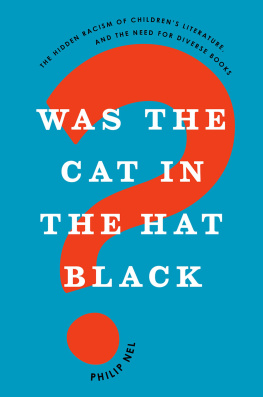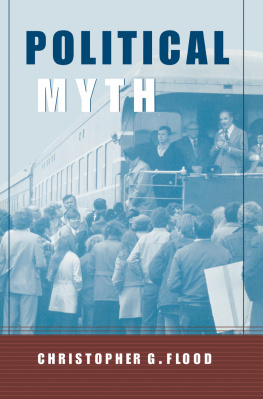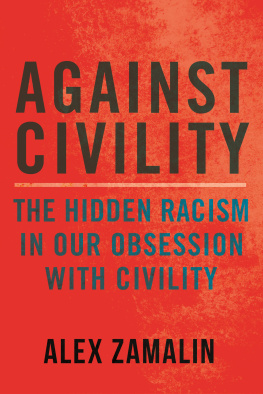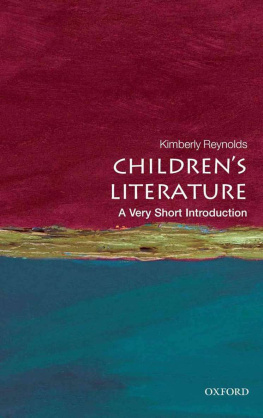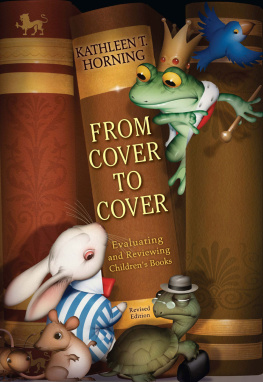Philip Nel - Was the Cat in the Hat Black? The Hidden Racism of Childrens Literature, and the Need for Diverse Books
Here you can read online Philip Nel - Was the Cat in the Hat Black? The Hidden Racism of Childrens Literature, and the Need for Diverse Books full text of the book (entire story) in english for free. Download pdf and epub, get meaning, cover and reviews about this ebook. year: 2017, publisher: Oxford University Press, genre: Art. Description of the work, (preface) as well as reviews are available. Best literature library LitArk.com created for fans of good reading and offers a wide selection of genres:
Romance novel
Science fiction
Adventure
Detective
Science
History
Home and family
Prose
Art
Politics
Computer
Non-fiction
Religion
Business
Children
Humor
Choose a favorite category and find really read worthwhile books. Enjoy immersion in the world of imagination, feel the emotions of the characters or learn something new for yourself, make an fascinating discovery.
- Book:Was the Cat in the Hat Black? The Hidden Racism of Childrens Literature, and the Need for Diverse Books
- Author:
- Publisher:Oxford University Press
- Genre:
- Year:2017
- Rating:4 / 5
- Favourites:Add to favourites
- Your mark:
- 80
- 1
- 2
- 3
- 4
- 5
Was the Cat in the Hat Black? The Hidden Racism of Childrens Literature, and the Need for Diverse Books: summary, description and annotation
We offer to read an annotation, description, summary or preface (depends on what the author of the book "Was the Cat in the Hat Black? The Hidden Racism of Childrens Literature, and the Need for Diverse Books" wrote himself). If you haven't found the necessary information about the book — write in the comments, we will try to find it.
Philip Nel: author's other books
Who wrote Was the Cat in the Hat Black? The Hidden Racism of Childrens Literature, and the Need for Diverse Books? Find out the surname, the name of the author of the book and a list of all author's works by series.
Was the Cat in the Hat Black? The Hidden Racism of Childrens Literature, and the Need for Diverse Books — read online for free the complete book (whole text) full work
Below is the text of the book, divided by pages. System saving the place of the last page read, allows you to conveniently read the book "Was the Cat in the Hat Black? The Hidden Racism of Childrens Literature, and the Need for Diverse Books" online for free, without having to search again every time where you left off. Put a bookmark, and you can go to the page where you finished reading at any time.
Font size:
Interval:
Bookmark:


Oxford University Press is a department of the University of Oxford. It furthers the Universitys objective of excellence in research, scholarship, and education by publishing worldwide. Oxford is a registered trade mark of Oxford University Press in the UK and certain other countries.
Published in the United States of America by Oxford University Press
198 Madison Avenue, New York, NY 10016, United States of America.
Philip Nel 2017
All rights reserved. No part of this publication may be reproduced, stored in a retrieval system, or transmitted, in any form or by any means, without the prior permission in writing of Oxford University Press, or as expressly permitted by law, by license, or under terms agreed with the appropriate reproduction rights organization. Inquiries concerning reproduction outside the scope of the above should be sent to the Rights Department, Oxford University Press, at the address above.
You must not circulate this work in any other form and you must impose this same condition on any acquirer.
Images 2.4 and 2.5 are illustrations by Mary Shepard from Mary Poppins by P.L. Travers.
Copyright 1934 and renewed 1962 by P.L. Travers. Reprinted by permission of Houghton Mifflin Harcourt Publishing Company. All Rights Reserved.
Disclaimer: This book is not in any way affiliated with or sponsored, endorsed or officially licensed by Dr. Seuss Enterprises, LP.
Library of Congress Cataloging-in-Publication Data
Names: Nel, Philip 1969 author.
Title: Was the cat in the hat black? : the hidden racism of childrens literature, and the need for diverse books / Philip Nel.
Description: Oxford University Press : New York, NY, 2017.
Identifiers: LCCN 2016045070 | ISBN 9780190635077 (hardback : alk. paper) | eISBN 9780190635091
Subjects: LCSH: Childrens literature, AmericanHistory and criticism. | Race in literature. | Racism in literature.
Classification: LCC PN1009.5.R32 N47 2017 | DDC 810.9/9282dc23
LC record available at https://lccn.loc.gov/2016045070
Special thanks to those whose work and advice I have benefited the most from: Robin Bernstein, Zetta Elliott, Cat Keyser, Cameron Leader-Picone, Michelle Martin, Ebony Elizabeth Thomas, and Karin Westman.
For offering suggestions and lending expertise, my thanks to: Michelle Abate, Melissa Adams-Campbell, Megan Montague Cash, Clmentine Beauvais, Natalia Cecire, Nina Christensen, Sarah Park Dahlen, Anna Mae Duane, Debra Dudek, Gerald Early, Brigitte Fielder, Amy Greer, Jerry Griswold, Marah Gubar, Daniel Hade, Erica Hateley, Jennifer Hughes, Cheryl Klein, Eric Lott, Beth Marshall, Christopher Myers, Don Pease, Scott Peeples, Debbie Reese, Teya Rosenberg, Lori Sabian, and Lara Saguisag.
For assistance in the pursuit of images and permissions, thanks to Bruce Tabb and Randy Sullivan (University of Oregon Libraries); Eric Reynolds and Paul Baresh (Fantagraphics); Kate Hart; Hannah Ehrlich (Lee & Low Books, Inc.); Margot Abel and Deborah Pope (The Ezra Jack Keats Foundation); Mary Sullivan (Penguin USA); Emily Dowdell (Peachtree Publishers); Alex Bradshaw (Penguin Random House UK); Carey Schroeter (Allen & Unwin); Vanthi Pham (ObeyGiant.com); Loren Spivack; Kate Hart; Charles Cohen; Naomi Wood; Joe Sutliff Sanders; Olga Holownia; Farah Mendlesohn; Kari Sperring; Jaclyn Dolamore. For lending their aesthetic expertise when I needed it, thanks to: Megan Montague Cash, Mark Newgarden, Mervi Pakaste, and Dan Warner.
A hearty thanks to all those in Eric Lotts group at the Futures of American Studies Seminar, June 2010: Ashley Carson Barnes, Alex Black, Todd Carmody, Alex Corey, Brigitte Fielder (again!), Michele Fazio, Erica Fretwell, Jack Hamilton, Elissa Underwood Marek, Marty Northrop, Jonathan Senchyne, and John Charles Williamson. Additional thanks go to Michelle Turgeon at Washington University (in St. Louis), for suggesting the notion of the Cat in the Hat as a biracial ambassador.
The idea for the title chapter (and thus the book) began when Anita Silvey mentioned that Annie Williams was African American. My thanks to her, and to Hollins Universitys Francelia Butler Childrens Literature Conference, at whose invitation I presented the first version of the title chapter, back in 2008.
For his patronage, thanks to the late Alvin Buenaventura (19762016): his generosity helped underwrite the sabbatical year during which this book was my central focus. While were on the subject, thanks to Kansas State University for the aforementioned sabbatical and for partially funding the travel to conferences at which this work was presented. Thanks to the conferences that granted me a venue in which to develop these chapters: the American Studies Association (2008, 2012, 20142016), Australasian Childrens Literature Association for Research (2014), Childrens Literature Association (2012, 2014, 2015), and the International Research Society for Childrens Literature (2011, 2013). Thanks, also, to the many people and institutions who invited me to present this when it was still a work in progress: University of Antwerp (Vanessa Joosen), DePauw University (Claudia Mills), Washington University (Gerald Early), College of Charleston (Scott Peeples), Dartmouth (Donald Pease), and Hollins (Leslie Wessel, Ellen Malven, and Amanda Cockrell).
Thanks to Carl Bromley, Zakia Henderson-Brown, and their colleague (whose name I regrettably failed to note) at the New Press for talking about the book with me. It especially helped me rethink the title chapter. Thanks, too, to New York University Presss Eric Zinner, with whom I have been talking about this book for several years now. I appreciate your support!
And, of course, a big thanks to Oxford University Press Sarah Pirovitz for her enthusiastic embrace of this book, and to Brendan ONeill for his support. The two anonymous readers of this manuscript offered the most helpful comments Ive received on any publication in my nearly two decades as an academic. I thank them heartilyIve benefited a great deal from their advice. Thanks, also, to the third anonymous reader who, in his or her review of the fourth and fifth chapters, led me to useful quantitative data Ive incorporated. An enthusiastic thanks to OUPs Lucas Heinrich for his clever cover. Thanks to project manager Prabhu Chinnasamy for overseeing the books final phases. Finally, thanks to copy-editors Johanna Baboukis and Raji Nirmal for their efforts in capitalization-consistency, typographical-errata-elimination, and general flaw-fixing.
I continue to find it strange that George Nicholson (19372015), who supported this project, is not around to see it publishedor to discuss future projects, or to meet for lunch whenever Im in New York. Yet I also feel extremely lucky to have found a new advocate and friend in InkWell Managements Stephen Barbara. Hes thorough, strategic, patient, and supportive. Come what may, I know that Stephen has my back. Thank you, Stephen!
In her oft-cited article, Larrick lamented that nonwhite children are learning to read and to understand the American way of life in books which either omit them entirely or scarcely mention them. These omissions damage the child of color, and may harm White children even more: Although his light skin makes him one of the worlds minorities, the white child learns from his books that he is the kingfish. There seems little chance of learning the humility so
Font size:
Interval:
Bookmark:
Similar books «Was the Cat in the Hat Black? The Hidden Racism of Childrens Literature, and the Need for Diverse Books»
Look at similar books to Was the Cat in the Hat Black? The Hidden Racism of Childrens Literature, and the Need for Diverse Books. We have selected literature similar in name and meaning in the hope of providing readers with more options to find new, interesting, not yet read works.
Discussion, reviews of the book Was the Cat in the Hat Black? The Hidden Racism of Childrens Literature, and the Need for Diverse Books and just readers' own opinions. Leave your comments, write what you think about the work, its meaning or the main characters. Specify what exactly you liked and what you didn't like, and why you think so.

